[M1 Mac, Big Sur 11.6.8, clang 13.0.0, FLTK 1.3.8, NO IDE]
すぐに分かるだろうと思っていたものの、そうでもなかったです。結構重要な機能のはずですが、かなりそっけない扱いです。まあSwingと比べてしまうのは酷でしょうか。
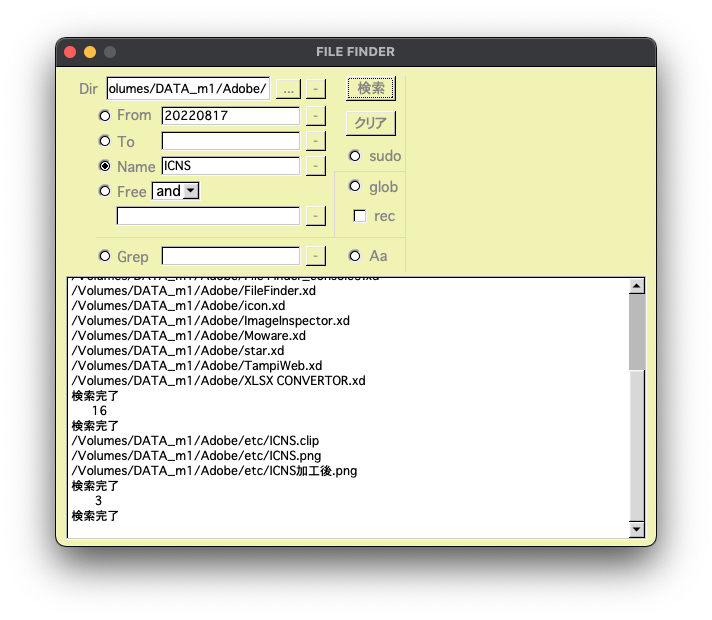
browser->load(outputText);
int line_num = browser->size(); // 全行数取得
browser->bottomline(line_num);[M1 Mac, Big Sur 11.6.8, clang 13.0.0, FLTK 1.3.8, NO IDE]
すぐに分かるだろうと思っていたものの、そうでもなかったです。結構重要な機能のはずですが、かなりそっけない扱いです。まあSwingと比べてしまうのは酷でしょうか。

browser->load(outputText);
int line_num = browser->size(); // 全行数取得
browser->bottomline(line_num);[M1 Mac, Big Sur 11.6.8, clang 13.0.0, FLTK 1.3.8, NO IDE]
コンソールコマンドによるファイル検索結果をFl_Multiline_Outputに表示しようとしてうまくいかず苦慮していましたが、検索結果を一旦テキストファイルとして出力し、Fl_Browserに読み込ませるとすんなりできました。テキストファイルはホームディレクトリ直下に置きました。
popen関数を使った場合はpclose関数で、fopen関数はfclose関数で閉じます。popenをfcloseで閉じようとしたために2回目以降の検索結果が表示されず、少し手間取ってしまいました。
これまではFl_Multiline_Outputがまともに使えない状態だったため、やむなくコンソール付き実行ファイルを使っていましたが、これでappファイルにて完結できるようになりました。
#define READ_SIZE 12800 // 検索結果は最大12800バイトまで
const char* outputText;
void outputTextMake(string cmd){
char str[READ_SIZE];
size_t ret;
FILE* fp = popen(cmd.c_str(), "r"); // コマンドに対する出力をFILE構造体として受け取る
FILE* fo = fopen(outputText, "a+"); // 検索結果を追記していく,起動時に削除初期化
while(1){
ret = fread(str, sizeof(char), READ_SIZE, fp);
fwrite(str, sizeof(char), ret, fo);
if(ret < READ_SIZE){
break;
}
}
// 文字列追記
string finish = "検索完了\n";
fprintf(fo, "%s", finish.c_str());
pclose(fp);
fclose(fo);
}// 出力ファイル名作成
const char* homedir = getenv("HOME");
cout << "homedir " << homedir << endl;
string outputText_str = string(homedir) + "/_filefinder.txt"; // 検索結果記録ファイルパス
outputText = outputText_str.c_str();
remove(outputText); // 削除初期化Fl_Browser *browser;
stringstream cmd;
cmd << "cd " << [選択したディレクトリパス] << " && " << "find `pwd` -type file ";
outputTextMake(cmd.str());
browser->load(outputText);[M1 Mac, Big Sur 11.6.8, clang 13.0.0, FLTK 1.3.8, NO IDE]
[C++] 138の続きです。
Fl_File_Browserをダブルクリックして上下層のディレクトリをブラウズできるようにしました。
Fl_File_Chooser::directory関数がポインタ演算を使っていてとても読みにくくメンテナンス性も低くなるため、この関数は使わないようにしました。ポインタ演算はかなりハード寄りの表現なので、オープンソースでは使わない方がいいように思います。
extern Fl_Input *dirInput;
extern FileChooser* chooser;
extern const char* dir_; // FileChooser内カレントディレクトリ
char selectPath[FL_PATH_MAX]; // 選択ファイルパス
vector<string> split(const string& str, char delim){
std::istringstream iss(str);
string tmp;
vector<string> res;
while (getline(iss, tmp, delim)) res.push_back(tmp);
return res;
}
void FileBrowserCB()
{
char *dirName;
const char* delim2 = "/";
// クリックしたディレクトリ名を取得
dirName = (char *)FileBrowser->Fl_Browser::text(FileBrowser->Fl_Browser::value());
cout << "dirName " << dirName << endl;
if (!dirName) return;
string dirNameStr = string(dirName);
// ディレクトリ名を絶対パスに変換
if (dirNameStr.compare("../") == 0){ // "../"をクリックした場合は上層へ移行
string dirStr = string(dir_);
cout << "dirStr " << dirStr << endl;
vector<string> dirStrList = split(dirStr);
dirStrList.pop_back();
std::ostringstream os;
std::copy(dirStrList.begin(), dirStrList.end(), std::ostream_iterator<std::string>(os, delim2));
std::string dirUpper = os.str();
cout << "dirUpper " << dirUpper << endl;
strcat(selectPath, dirUpper.c_str());
} else {
strcat(selectPath, dir_);
strcat(selectPath, dirName);
}
cout << "selectPath " << selectPath << endl;
if (Fl::event_clicks()) {
cout << "ダブルクリックしました" << endl;
// 選択したディレクトリの内容を表示し、カレントディレクトリdir_を更新
if (std::filesystem::is_directory(selectPath)){
FileBrowser->load(selectPath);
char* dir_0 = new char[strlen(selectPath) + 1];
strcpy(dir_0, selectPath);
dir_ = dir_0;
}
if (string(dir_).compare("/") == 0){
cout << "この階層が上限です" << endl;
return;
}
cout << "ダブルクリック後 dir_ " << dir_ << endl;
selectPath[0] = '\0';
return;
}
//選択ディレクトリ名を表示
inputFileName->value("");
inputFileName->value(selectPath);
// カレントディレクトリdir_確認
cout << "dir_ " << dir_ << endl;
selectPath[0] = '\0';
}
void btnOKCB(Fl_Return_Button*, void*)
{
const char* dir = inputFileName->value();
dirInput->value(dir);
chooser->Fl_Window::hide();
}[M1 Mac, Big Sur 11.6.8, clang 13.0.0, FLTK 1.3.8, NO IDE]
前回の続きです。
他のウィジェットと同様に後から色や線種などを変えられるようにしました。
Lineクラス作成を通してFl_Widgetの仕組みが理解できたのは収穫でした。
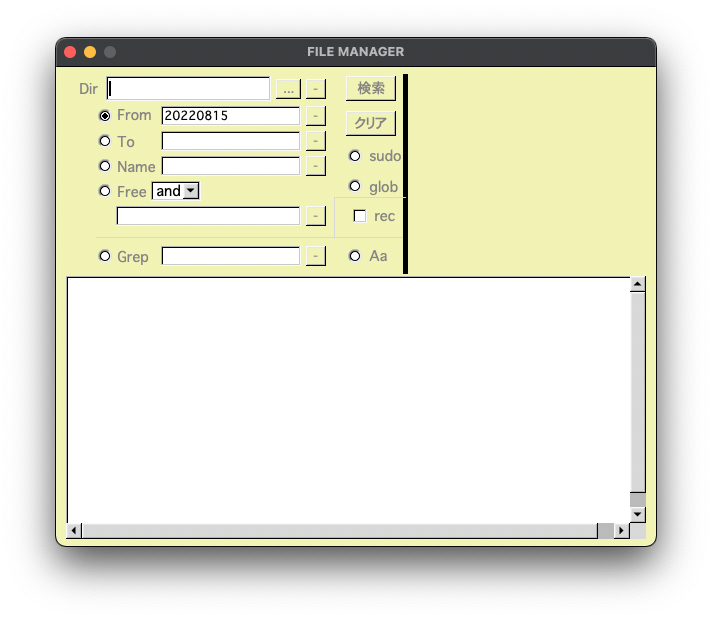
#pragma once
#include <FLstd.h>
#include <cppstd.h>
class Line: public Fl_Widget
{
int styletype_, stylewidth_;
Fl_Color color_;
public:
enum {
FL_SOLID = 0 , FL_DASH = 1 , FL_DOT = 2 , FL_DASHDOT = 3 ,
FL_DASHDOTDOT = 4 , FL_CAP_FLAT = 0x100 , FL_CAP_ROUND = 0x200 , FL_CAP_SQUARE = 0x300 ,
FL_JOIN_MITER = 0x1000 , FL_JOIN_ROUND = 0x2000 , FL_JOIN_BEVEL = 0x3000
};
Line(int x,int y, int w,int h);
~Line();
void draw();
Fl_Color color() const {return color_;}
void color(Fl_Color bg) {color_ = bg;}
vector<int> style() const {return {styletype_, stylewidth_};}
void style(int type, int width) {styletype_= type; stylewidth_= width;}
};#include <FLstd.h>
#include <cppstd.h>
#include <Line.h>
Line::Line(int x,int y, int w,int h):Fl_Widget(x,y,w,h){
styletype_ = FL_SOLID;
stylewidth_ = 1;
color_ = FL_GRAY;
}
Line::~Line(){}
void Line::draw(){
Fl_Color color1 = color();
fl_color(color1);
vector<int> style1 = style();
fl_line_style(style1[0],style1[1]);
int x1 = x(), y1 = y();
int x2 = x()+ w(), y2 = y()+ h();
fl_line(x1,y1,x2,y2);
}Line *line1 = new Line(40,171,309,0);
Line *line2 = new Line(349,10,0,195);
line2->color(fl_rgb_color(0,0,0));
line2->style(Line::FL_CAP_SQUARE,5);
Line *line3 = new Line(278,131,71,0);
Line *line4 = new Line(278,131,0,41);[M1 Mac, Big Sur 11.6.8, clang 13.0.0, FLTK 1.3.8, NO IDE]
[C++] 139の続きです。
前の記事では線の座標と長さを引数で設定しましたが、色や線種・太さを追加しました。
x()関数をヒントにrgb()関数とstyle()関数を作成し、これらの戻り値で設定値を取得できるようにしました。
引数が多いとコードを見てもどの引数が何を設定しているのか分かりにくいので、後ろ5つは省略可能にしました。デフォルトは太さ1の黒い実線になります。
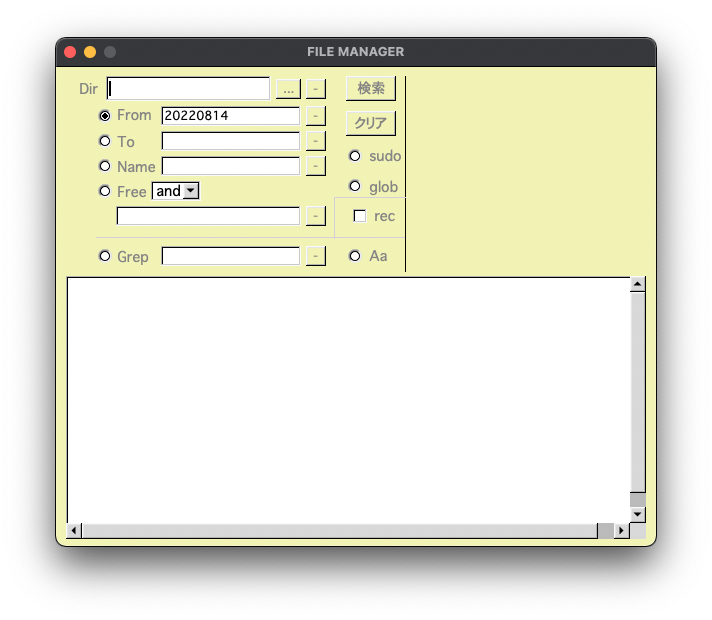
#include <FLstd.h>
#include <cppstd.h>
#include <Line.h>
Line::Line(int x,int y, int w,int h, int r, int g, int b, int styletype, int stylewidth):Fl_Widget(x,y,w,h){
r_ = r, g_ = g, b_ = b;
styletype_ = styletype, stylewidth_ = stylewidth;
}
Line::~Line(){}
void Line::draw(){
vector<int> rgb1 = rgb();
fl_color(fl_rgb_color(rgb1[0], rgb1[1], rgb1[2]));
vector<int> style1 = style();
fl_line_style(style1[0],style1[1]);
int x1 = x(), y1 = y();
int x2 = x()+ w(), y2 = y()+ h();
fl_line(x1,y1,x2,y2);
}#pragma once
#include <FLstd.h>
#include <cppstd.h>
class Line: public Fl_Widget
{
int r_, g_, b_;
int styletype_, stylewidth_;
public:
Line(int x,int y, int w,int h, int r = 0, int g = 0, int b = 0, int styletype = 0, int stylewidth = 1);
~Line();
void draw();
vector<int> rgb() const {return {r_,g_,b_};}
vector<int> style() const {return {styletype_, stylewidth_};}
};#include "Line.h"
Line *line1 = new Line(40,171,309,0,211,207,217,0,1);
Line *line2 = new Line(349,10,0,195); // デフォルトの黒い実線
Line *line3 = new Line(278,131,71,0,211,207,217,0,1);
Line *line4 = new Line(278,131,0,41,211,207,217,0,1);[M1 Mac, Big Sur 11.6.8, clang 13.0.0, wxWidgets 3.2.0, NO IDE]
最近FLTKの独特な仕様に振り回されることが多くなってきたので、他のウィジェットツールキットも試してみます。
前からチェックしていたwxWidgetsを導入してみました。インストールだけならHomebrewでできます。最新の3.2.0をインストールしました。
brew install wxwidgetsソースコードやサンプル、デモを確認したい場合はGitHubからダウンロードしてビルドします。3.2.0はなぜかpngフォルダが空なので3.1.7をダウンロードしました。
コマンドは以下の通りです。
# 本体のビルド
mkdir build-cocoa-debug
cd build-cocoa-debug
../configure --with-opengl --disable-shared --enable-monolithic \
--with-libjpeg --with-libtiff=builtin --with-libpng --with-zlib \
--with-mac --disable-sdltest --enable-unicode --enable-display \
--enable-propgrid --disable-webview --prefix=/Users/[ユーザ名]/Dev/wxWidgets-staticlib \
CXXFLAGS="-std=c++0x" --with-libiconv=/usr
make
# サンプルとデモのビルド
cd samples; make;cd ..
cd demos; make;cd ..wxWidgetsはOSのLook&Feelを採用しており、macOSの場合はCocoa風になります。
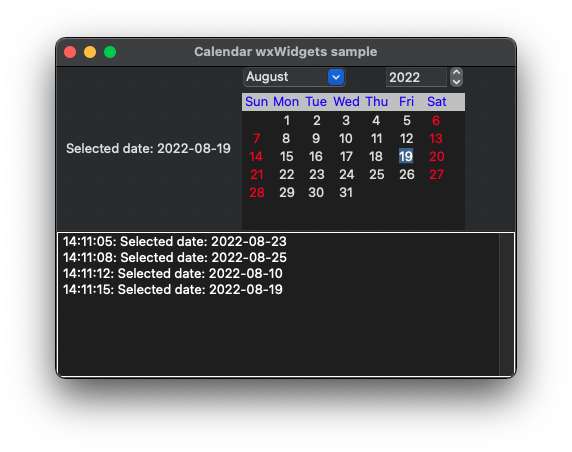
[M1 Mac, Big Sur 11.6.8, clang 13.0.0, FLTK 1.3.8, NO IDE]
4月に書いた[C++] 48の記事以降、その内容が最善な方法ではないと自覚していて、ずっともやもやしていたのですが、ようやくシンプルに線を描けるようになりました。
Fl_Widgetを継承したLineクラスのdraw()関数内でx()関数、y()関数、w()関数、h()関数を使うことで解決しました。
x()ではなくgetx()だったら瞬時に意味を理解していたと思いますが、引数の有無でgetとsetを使い分けるのがFLTKの仕様ですから慣れるしかないです。
FLTKはいいツールだというのに、こういった癖の強いところでC++ユーザーに受け入れられないのではと思います。せめてLineクラスは標準Widgetとして用意しておくべきでしょう。
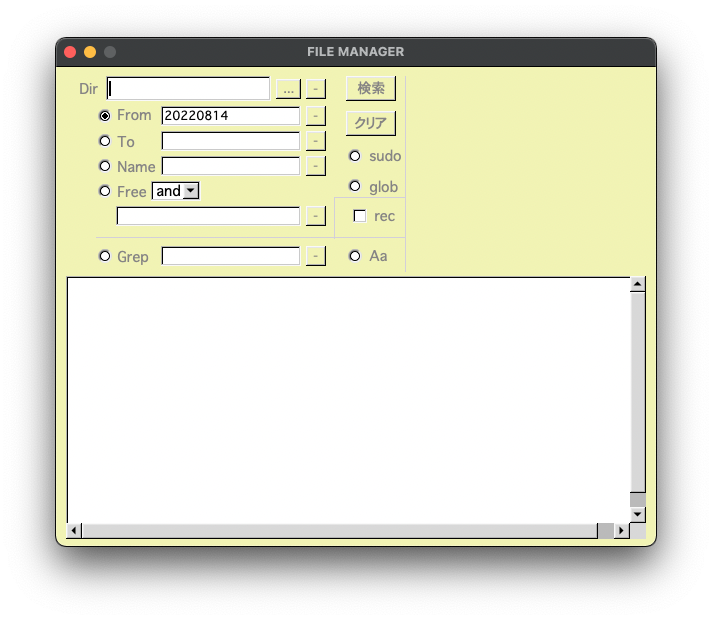
#include <Line.h>
Line::Line(int x,int y, int w,int h):Fl_Widget(x,y,w,h){
}
Line::~Line(){}
void Line::draw(){
fl_color(fl_rgb_color(211,207,217));
fl_line_style(0,1);
int x1 = x(), y1 = y();
int x2 = x()+ w(), y2 = y()+ h();
fl_line(x1,y1,x2,y2);
}#pragma once
#include <FLstd.h> // 自製
#include <cppstd.h> // 自製
class Line: public Fl_Widget
{
public:
Line(int x,int y, int w, int h);
~Line();
void draw();
};#include "Line.h"
Line *line1 = new Line(40,171,309,0);
Line *line2 = new Line(349,10,0,195);
Line *line3 = new Line(278,131,71,0);
Line *line4 = new Line(278,131,0,41);[M1 Mac, Big Sur 11.6.8, clang 13.0.0, FLTK 1.3.8, NO IDE]
ダブルクリック時の条件分岐にはFl::event_clicks()を使います。Fl_File_Chooser2.cppのソースコードを読んでその存在を知りました。公式サイトのEvents handling functionsに説明があります。
FLTKは結構使い込んでいますが、まだまだ知らないことだらけです。
void FileBrowserCB()
{
char *fileName;
if (Fl::event_clicks()) {
cout << "ダブルクリックしました" << endl;
// 以下、ダブルクリックした時の動作を書く
}
// クリックしたファイルのファイル名を取得
fileName = (char *)FileBrowser->Fl_Browser::text(FileBrowser->Fl_Browser::value());
cout << "fileName " << fileName << endl;
if (!fileName) return;
selectPath[0] = '\0';
// ディレクトリ名にファイル名を結合
strcat(selectPath ,appDir);
strcat(selectPath ,"/");
strcat(selectPath ,fileName);
cout << "selectPath " << selectPath << endl;
if (browserType == 1) { // FL_MULTI_BROWSERになっている場合
char* name = new char[strlen(selectPath) + 1];
strcpy(name, selectPath);
selectPaths.push_back(name);
}
//ファイルパスを表示
inputFileName->value("");
inputFileName->value(selectPath);
}[M1 Mac, Big Sur 11.6.8, clang 13.0.0, FLTK 1.3.8, NO IDE]
先月7月上旬で開発を中断していたファイル検索アプリをさらにグレードアップさせることにしました。
とりあえずカラーアプリ製作時に作成したFileChooserを導入しましたが、これは固定したディレクトリからファイルを選択する機能しかないため、ファイルブラウザとしての機能を追加する必要があります。
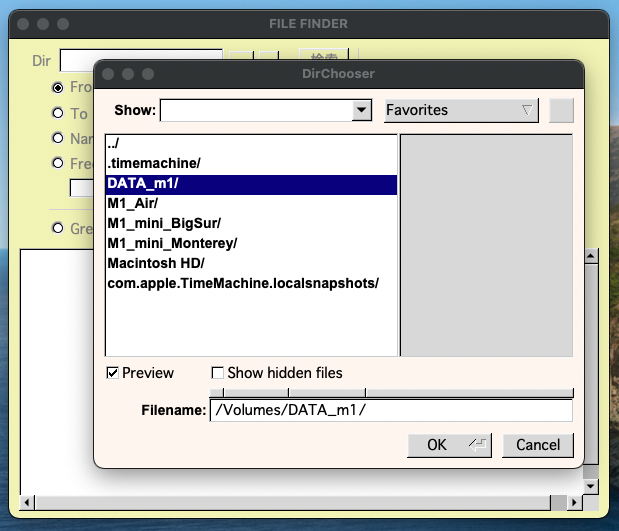
[M1 Mac, Big Sur 11.6.8, clang 13.0.0, FLTK 1.3.8, NO IDE, C++17]
前回の続きです。
サイズ的にはあまり重要ではありませんが、Thumnail Mediaディレクトリも空にするようにしました。
これでFinal Cut Library ManagerというアプリのClean機能と同等になりました。
void FCPClean(){
string dirPath = "/movie"; // ライブラリ保存ディレクトリ
vector<string> paths = getFilePath(dirPath, "fcpbundle");
int num = 1;
for (string path:paths){
cout << num << " " << path << endl;
vector<string> dirs = getDirPath(path);
int num2 = 1;
for (string dir:dirs){
if (dir.find("High Quality Media") != std::string::npos){
cout << "High Quality Mediaディレクトリ " << num2 << " " << dir << endl;
struct stat statBuf;
int detect = stat(dir.c_str(), &statBuf);
if (detect == 0){
vector<string> dirs2 = getDirPath(dir);
for (string dir:dirs2){
cout << "削除対象dir " << dir << endl;
std::filesystem::remove_all(dir);
}
} else {
cout << "ディレクトリは削除済みです" << endl;
}
num2 += 1;
}
}
int num3 = 1;
for (string dir:dirs){
if (dir.find("Thumbnail Media") != std::string::npos){
cout << "Thumbnail Mediaディレクトリ " << num3 << " " << dir << endl;
struct stat statBuf;
int detect = stat(dir.c_str(), &statBuf);
if (detect == 0){
vector<string> dirs2 = getDirPath(dir);
for (string dir:dirs2){
cout << "削除対象dir " << dir << endl;
std::filesystem::remove_all(dir);
}
} else {
cout << "ディレクトリは削除済みです" << endl;
}
num3 += 1;
}
}
num += 1;
}
output_line->insert("FCP Clean完了!\n");
}